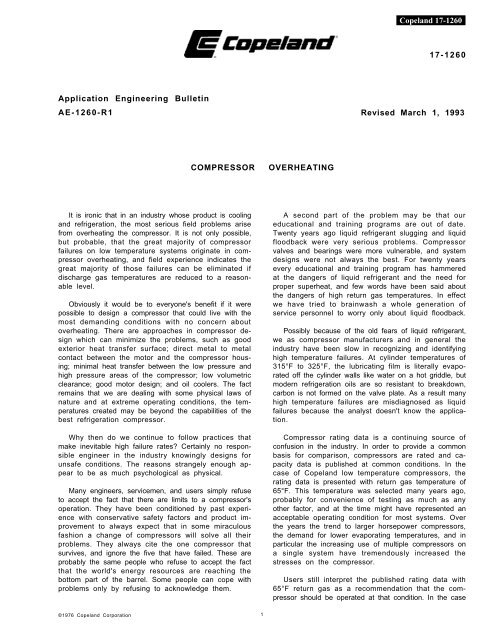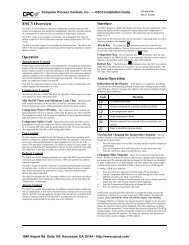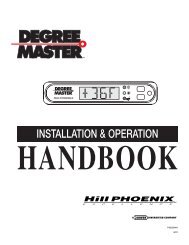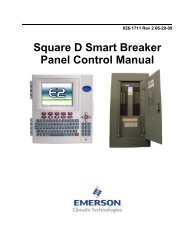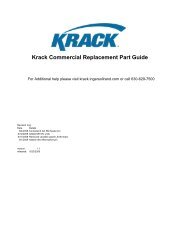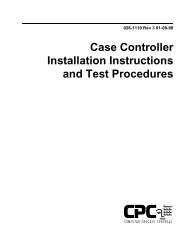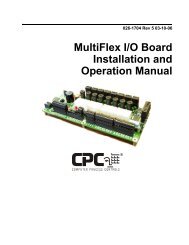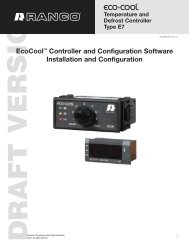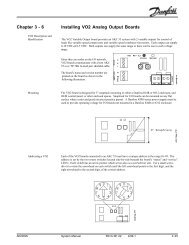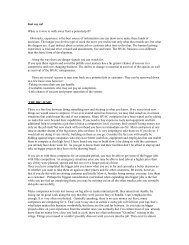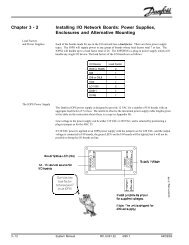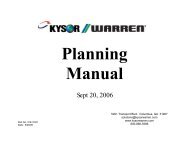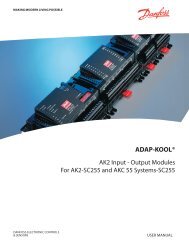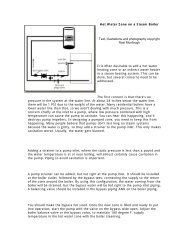Copeland Compressor
Copeland Compressor
Copeland Compressor
Create successful ePaper yourself
Turn your PDF publications into a flip-book with our unique Google optimized e-Paper software.
<strong>Copeland</strong> 17-1260<br />
17-1260<br />
Application Engineering Bulletin<br />
AE-1260-R1 Revised March 1, 1993<br />
COMPRESSOR<br />
OVERHEATING<br />
It is ironic that in an industry whose product is cooling<br />
and refrigeration, the most serious field problems arise<br />
from overheating the compressor. It is not only possible,<br />
but probable, that the great majority of compressor<br />
failures on low temperature systems originate in compressor<br />
overheating, and field experience indicates the<br />
great majority of those failures can be eliminated if<br />
discharge gas temperatures are reduced to a reasonable<br />
level.<br />
Obviously it would be to everyone's benefit if it were<br />
possible to design a compressor that could live with the<br />
most demanding conditions with no concern about<br />
overheating. There are approaches in compressor design<br />
which can minimize the problems, such as good<br />
exterior heat transfer surface; direct metal to metal<br />
contact between the motor and the compressor housing;<br />
minimal heat transfer between the low pressure and<br />
high pressure areas of the compressor; low volumetric<br />
clearance; good motor design; and oil coolers. The fact<br />
remains that we are dealing with some physical laws of<br />
nature and at extreme operating conditions, the temperatures<br />
created may be beyond the capabilities of the<br />
best refrigeration compressor.<br />
Why then do we continue to follow practices that<br />
make inevitable high failure rates? Certainly no responsible<br />
engineer in the industry knowingly designs for<br />
unsafe conditions. The reasons strangely enough appear<br />
to be as much psychological as physical.<br />
Many engineers, servicemen, and users simply refuse<br />
to accept the fact that there are limits to a compressor's<br />
operation. They have been conditioned by past experience<br />
with conservative safety factors and product improvement<br />
to always expect that in some miraculous<br />
fashion a change of compressors will solve all their<br />
problems. They always cite the one compressor that<br />
survives, and ignore the five that have failed. These are<br />
probably the same people who refuse to accept the fact<br />
that the world's energy resources are reaching the<br />
bottom part of the barrel. Some people can cope with<br />
problems only by refusing to acknowledge them.<br />
A second part of the problem may be that our<br />
educational and training programs are out of date.<br />
Twenty years ago liquid refrigerant slugging and liquid<br />
floodback were very serious problems. <strong>Compressor</strong><br />
valves and bearings were more vulnerable, and system<br />
designs were not always the best. For twenty years<br />
every educational and training program has hammered<br />
at the dangers of liquid refrigerant and the need for<br />
proper superheat, and few words have been said about<br />
the dangers of high return gas temperatures. In effect<br />
we have tried to brainwash a whole generation of<br />
service personnel to worry only about liquid floodback.<br />
Possibly because of the old fears of liquid refrigerant,<br />
we as compressor manufacturers and in general the<br />
industry have been slow in recognizing and identifying<br />
high temperature failures. At cylinder temperatures of<br />
315°F to 325°F, the lubricating film is literally evaporated<br />
off the cylinder walls like water on a hot griddle, but<br />
modern refrigeration oils are so resistant to breakdown,<br />
carbon is not formed on the valve plate. As a result many<br />
high temperature failures are misdiagnosed as liquid<br />
failures because the analyst doesn't know the application.<br />
<strong>Compressor</strong> rating data is a continuing source of<br />
confusion in the industry. In order to provide a common<br />
basis for comparison, compressors are rated and capacity<br />
data is published at common conditions. In the<br />
case of <strong>Copeland</strong> low temperature compressors, the<br />
rating data is presented with return gas temperature of<br />
65°F. This temperature was selected many years ago,<br />
probably for convenience of testing as much as any<br />
other factor, and at the time might have represented an<br />
acceptable operating condition for most systems. Over<br />
the years the trend to larger horsepower compressors,<br />
the demand for lower evaporating temperatures, and in<br />
particular the increasing use of multiple compressors on<br />
a single system have tremendously increased the<br />
stresses on the compressor.<br />
Users still interpret the published rating data with<br />
65°F return gas as a recommendation that the compressor<br />
should be operated at that condition. In the case<br />
©1976 <strong>Copeland</strong> Corporation 1
<strong>Copeland</strong> 17-1260<br />
of smaller, single compressor systems operating at<br />
more moderate suction pressures, 65°F may still be<br />
acceptable, but on larger, more sophisticated equipment,<br />
lower return gas temperatures are required if the<br />
compressor is to be maintained within acceptable temperature<br />
limits.<br />
Refrigeration is not an exact science. System operation<br />
can be drastically affected by many variables in the<br />
field installation and operation, and since each party<br />
would like to believe that all problems are the fault of<br />
someone else, unfortunately there are widely varying<br />
opinions on every aspect of system performance. It is<br />
easy to understand the difficulty of the final user in<br />
intelligently evaluating and specifying the reliability that<br />
he might truly desire. It is easy to understand the<br />
difficulty of the design engineer in maintaining conservative<br />
design factors based on only his good judgement<br />
when the analysis of failures is cloudy, and he is subject<br />
to the tremendous cost pressures of a fiercely price<br />
competitive industry.<br />
At a meeting of service managers from several large<br />
commercial refrigeration manufacturers, it was unanimously<br />
agreed that compressor overheating is the<br />
greatest single field problem existent today, and the one<br />
on which the least headway was being made in solving<br />
the problem at the user level. If we are to make any<br />
major reduction in failure rates due to overheating, it is<br />
essential that there be widespread understanding of the<br />
problem in the industry.<br />
For those that refuse to accept the fact that there is<br />
a problem, little can be done. The encouraging side of<br />
the picture is the fact that for those that are willing to<br />
make the effort, low temperature overheating failures<br />
can be stopped dead.<br />
Temperature Limits<br />
Most refrigeration oils will start to break down or<br />
carbonize at temperatures of 350°F. Tests in a contaminant<br />
free atmosphere may indicate a reasonable tolerance<br />
for even higher temperatures, but the real world is<br />
inhabited by a multitude of systems that have varying<br />
degrees of contaminants such as air and moisture.<br />
Extreme ring and piston wear can occur at cylinder<br />
temperatures of 310-330°F with little oil carbonization.<br />
There is growing evidence that modern refrigeration oils<br />
have been so highly refined to obtain good solubility and<br />
high breakdown temperatures that the oil is unable to<br />
maintain a lubricating film at high temperatures.<br />
Field experience in general would indicate for good<br />
long life characteristics, piston, ring, and valve port<br />
temperatures should be maintained below 300°F. Normally<br />
discharge line temperatures within 6 inches of the<br />
compressor outlet will be from 50°F to 75°F cooler than<br />
cylinder and piston temperatures, depending on the<br />
compressor design and the refrigerant mass flow. Therefore<br />
as a general rule, 275°F discharge line temperatures<br />
represent a certain failure temperature condition,<br />
250°F is usually a danger level, and 225°F and below<br />
are desirable for reasonable life expectancy.<br />
There are different opinions in the industry on oil<br />
sump temperatures. The viscosity of the common refrigeration<br />
oils decreases rapidly as the temperature increases,<br />
and becomes dangerously low at temperatures<br />
of 200°F and above. At high temperatures the<br />
characteristics of the lubricant are critical, additives may<br />
be necessary, and bearings must be capable of withstanding<br />
the extreme temperatures. Lower temperatures<br />
are generally much more conducive to long life.<br />
Low Temperature R-502 Applications<br />
Few users realize the critical nature of single stage<br />
low temperature refrigeration. The supermarket manager<br />
demands brick hard -20°F ice cream; the blast<br />
freezer operator demands tunnel temperatures of -40°F<br />
for faster processing; the ice cream distributor demands<br />
-25°F truck body temperatures; each thinking only of<br />
satisfying his temperature demand, and none of them<br />
realizing their demands are an almost certain death<br />
sentence for the compressor. The normal low temperature<br />
evaporating limit for single stage compressors is -<br />
40°F, and although this can be extended to intermittent<br />
periods of operation down to -50°F, operation below -<br />
50°F (0 psig with R-502) creates discharge temperatures<br />
which can destroy the compressor.<br />
In a similar fashion, the contractor or original equipment<br />
manufacturer who for reasons of convenience or<br />
expediency cycles the fan providing compressor cooling,<br />
or locates the compressor so that adequate cooling<br />
air cannot impinge directly on the compressor may<br />
unwittingly be creating the same critical temperature<br />
conditions. At low temperature operating conditions the<br />
decreasing density of the refrigerant vapor and the<br />
heating effect of high compression ratios combine to<br />
create high discharge temperatures which cannot be<br />
controlled by refrigerant cooling alone. The additional<br />
heat transfer gained form a direct air blast on the<br />
compressor is absolutely essential for compressor survival,<br />
and any decrease in the recommended airflow or<br />
loss of direct impingement on the compressor can lead<br />
directly to excessive cylinder temperatures.<br />
At todays demanding temperature conditions, a low<br />
temperature compressor may be operating right on the<br />
edge of its survival limits. The lower the evaporating<br />
temperature and the higher the condensing temperature<br />
the more critical the discharge temperature becomes.<br />
The only way to insure reasonable discharge<br />
temperatures at extreme conditions is by means of very<br />
low return gas temperature.<br />
Table 1 illustrates some typical internal temperatures<br />
on low temperature compressors with 65°F return gas<br />
temperature, a common field condition. The cylinder<br />
temperatures have been calculated based on a 75°F<br />
increase in the return gas temperature after entering the<br />
compressor and prior to entering the cylinder on the<br />
suction stroke. The 75°F temperature increase is typical<br />
of that found in laboratory testing, and is caused by heat<br />
transfer form the motor and compressor body. The final<br />
column in the table is the return gas temperature<br />
entering the compressor that would be necessary to<br />
maintain internal cylinder temperatures below 300°F.<br />
2
Undoubtedly with operating wear, the temperature<br />
conditions become even more severe. Table 1 data is<br />
calculated based on laboratory testing, but individual<br />
installations vary, and the goal should be to maintain<br />
temperatures on the discharge line six inches from the<br />
compressor at 225°F or less.<br />
Due to the danger of freezing in underground trenches<br />
and sweating in the machine room, low return gas<br />
temperatures cannot be achieved in a typical supermarket<br />
with uninsulated suction lines. The increasing incidence<br />
of low temperature failures form overheating<br />
indicates some major change in design approach is<br />
required to improve system reliability.<br />
One large mid-western chain decided to attack this<br />
problem in the early 1970's with spectacular results.<br />
They set the expansion valves for low superheat control,<br />
completely insulated the suction lines to the compressor<br />
service valves, provided cool air ventilation for<br />
the machine room, with the result that compressor<br />
failures have been almost completely eliminated.<br />
The need for completely insulating suction lines on<br />
low temperature systems seems clearly indicated, and<br />
is highly recommended to improve compressor life and<br />
reliability.<br />
R-22 Applications<br />
An equally critical temperature condition can occur<br />
on R-22 systems with evaporating temperatures below<br />
10°F. Unfortunately many medium temperature R-22<br />
systems designed for nominal evaporating temperatures<br />
of 5°F or 10°F wind up operating at suction<br />
pressures equivalent to evaporating temperatures of -<br />
10°F or lower, and such installations can develop severe<br />
problems. Note that it is the suction pressure at the<br />
compressor which is critical, not the case evaporating<br />
temperature, since in many cases the critical threat is<br />
caused by pressure drop between the case and the<br />
compressor.<br />
<strong>Copeland</strong> 17-1260<br />
Table 2 illustrates some typical internal temperatures<br />
on medium temperature applications with R-22.<br />
As in the case of R-502, the cylinder temperatures have<br />
been calculated based on a 75°F increase in the return<br />
gas temperature after entering the compressor and<br />
prior to entering the cylinder.<br />
Demand<br />
Cooling<br />
Overheating of R-22 systems operating at evaporator<br />
temperatures below 10°F can be avoided by direct<br />
liquid injection into the compressor. This "Demand<br />
Cooling®" system utilizes solid state electronics to<br />
inject liquid only when required thereby improving system<br />
efficiency compared to mechanical injection systems.<br />
Desuperheating Expansion Valves<br />
On existing systems with uninsulated lines where it<br />
may not be possible to change the system operating<br />
conditions, the only means of reducing discharge temperatures<br />
to an acceptable level may be with a<br />
desuperheating expansion valve.<br />
Extensive field testing on problem installations revealed<br />
that discharge temperatures could be reduced<br />
almost degree for degree by reducing return gas temperatures.<br />
Repeatedly we found systems operating with<br />
250°F to 260°F discharge line temperatures and 60°F<br />
return gas temperatures could be modified with a<br />
desuperheating expansion valve to obtain discharge<br />
line temperatures below 225°F with return gas temperatures<br />
of approximately 30°F.<br />
The desuperheating valves were installed within<br />
three to six feet of the compressor suction valve with the<br />
suction line insulated from the expansion valve to the<br />
compressor inlet. Initially ton valves were tried, but<br />
better performance was obtained with nominal one ton<br />
valves with compressors in the 7 H.P. to 25 H.P.<br />
range. Several alternate expansion valve charges were<br />
Table 1<br />
Typical R-502 Cylinder<br />
Discharge Gas Temperatures<br />
Saturated<br />
Evaporating<br />
Temperature<br />
At<br />
<strong>Compressor</strong><br />
Suction<br />
Presssure<br />
Saturated<br />
Condensing<br />
Temperature At<br />
<strong>Compressor</strong><br />
Discharge<br />
Pressure<br />
Typical<br />
Return Gas<br />
Temp.<br />
Cylinder<br />
Discharge<br />
Temperature<br />
Return Gas<br />
Temperature<br />
Necessary To<br />
Limit Discharge<br />
Temp. To 300 ºF<br />
-40ºF 130ºF 65ºF 340ºF 20ºF<br />
-40ºF 120ºF 65ºF 335ºF 35ºF<br />
-40ºF 110ºF 65ºF 320ºF 45ºF<br />
-25ºF 130ºF 65ºF 320ºF 45ºF<br />
-25ºF 120ºF 65ºF 310ºF 55ºF<br />
-25ºF 110ºF 65ºF 300ºF 65ºF<br />
3
<strong>Copeland</strong> 17-1260<br />
tried but satisfactory performance was obtained only<br />
with the following;<br />
Sporlan GR-1-L1<br />
Alco LCL2E-IE.<br />
If suction lines can be insulated, desuperheating<br />
valves are not necessary, but desuperheating valves do<br />
offer a means of reducing temperatures on systems<br />
where no other approach is possible.<br />
Liquid to Suction Heat Exchangers<br />
Liquid to suction heat exchangers in refrigeration<br />
systems are useful in raising the return gas temperature<br />
to prevent frosting or condensation, to evaporate any<br />
liquid droplets in the vapor stream, and to subcool the<br />
liquid to prevent flash gas in the liquid line.<br />
However there appears to be some misunderstanding<br />
in the industry regarding any capacity increase as<br />
the result of a heat exchanger. To the extent that heat<br />
absorbed by the vapor from the liquid refrigerant displaces<br />
heat that might be picked up from the ambient or<br />
other non-refrigerated spaces there is a capacity increase,<br />
and therefore on systems with uninsulated<br />
suction lines there is normally an increase.<br />
The mere transfer of heat from liquid to suction does<br />
not in itself add any significant capacity or efficiency to<br />
the system. While the enthalpy of the liquid will be<br />
decreased, thus increasing the enthalpy change per<br />
pound in the evaporator, the warmer vapor has a higher<br />
specific volume (cubic feet per pound) so the pumping<br />
capacity of the compressor will be decreased. These<br />
two factors, the decreased enthalpy of the liquid and the<br />
higher specific volume of the vapor, largely cancel out<br />
the effect of each individually, so the net effect is small,<br />
and if the liquid line loses any temperature in transit, it<br />
is doubtful if any increase is measurable.<br />
With insulated suction lines the heat exchanger not<br />
only loses its capacity benefit, but may actually be a<br />
threat if it raises the temperature of the return gas<br />
excessively. In particular, liquid to suction heat exchanger<br />
in the machine room at the compressor may<br />
actually contribute to compressor failure if they elevate<br />
the temperature of the return gas beyond an acceptable<br />
level. This is especially critical on R-22 low temperature<br />
applications.<br />
Summary<br />
<strong>Compressor</strong> overheating has become and remains a<br />
major field problem primarily because few people recognize<br />
or understand the pattern of failure. In todays large<br />
sophisticated systems, lower return gas temperatures<br />
are essential, and it appears the most direct way of<br />
accomplishing this is by insulating suction lines. While<br />
this will increase the initial system cost, field experience<br />
indicates the reduction in compressor failure rates can<br />
quickly repay the added investment.<br />
On existing systems where insulating lines is not<br />
feasible, desuperheating expansion valves have been<br />
proven to be an effective means of obtaining lower<br />
discharge temperatures.<br />
Table 2<br />
Typical R-22 Cylinder<br />
Discharge Gas Temperatures<br />
Saturated<br />
Evaporating<br />
Temperature At<br />
<strong>Compressor</strong><br />
Suction<br />
Presssure<br />
Saturated<br />
Condensing<br />
Temperature At<br />
<strong>Compressor</strong><br />
Discharge<br />
Pressure<br />
Typical<br />
Return Gas<br />
Temp.<br />
Cylinder<br />
Discharge<br />
Temperature<br />
Return Gas<br />
Temperature<br />
Neccessary To Limit<br />
Discharge Temp. To<br />
300 ºF<br />
-10ºF 130ºF 65ºF 365ºF 5ºF<br />
-10ºF 120ºF 65ºF 350ºF 25ºF<br />
-10ºF 110ºF 65ºF 340ºF 35ºF<br />
0ºF 130ºF 65ºF 335ºF 25ºF<br />
0ºF 120ºF 65ºF 320ºF 45ºF<br />
0ºF 110ºF 65ºF 310ºF 50ºF<br />
10ºF 130ºF 65ºF 320ºF 45ºF<br />
10ºF 120ºF 65ºF 300ºF 65ºF<br />
10ºF 110ºF 65ºF 290ºF 65ºF<br />
<strong>Copeland</strong> Corporation<br />
Sidney, Ohio 45365-0669 U.S.A.<br />
4<br />
Printed in U.S.A.


